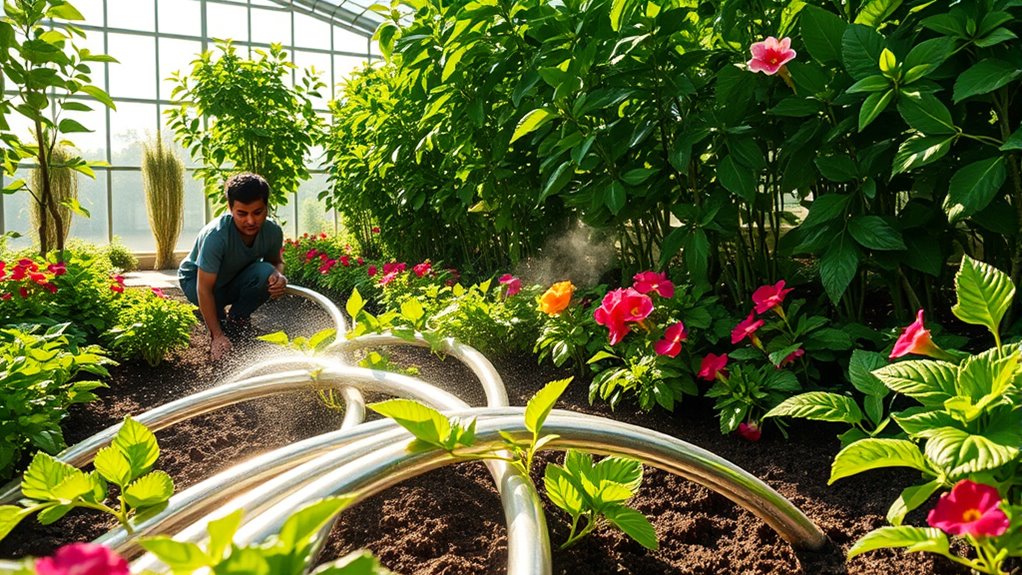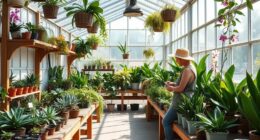Setting up an efficient irrigation system in your greenhouse starts with evaluating your crops’ water needs and assessing your water source. Gather essential materials like tubing, emitters, and timers, then connect the system to a reliable water source. Once installed, test for leaks and adjust placements according to plant requirements. To maximize effectiveness, monitor water usage and maintain your system regularly. You’ll discover even more tips to enhance your setup as you go along!
Key Takeaways
- Assess the specific water needs of your greenhouse crops to design an efficient irrigation system.
- Choose appropriate irrigation methods such as drip, subirrigation, or hand watering based on plant requirements and available resources.
- Connect the system to a reliable water source and install essential components like timers and filters for optimal operation.
- Regularly monitor soil moisture levels and adjust irrigation schedules as plants grow to ensure efficient water usage.
- Maintain the system through routine inspections, filter cleaning, and leak detection to promote longevity and effectiveness.
Planning and Design Considerations

When planning your greenhouse irrigation system, it’s crucial to first consider the specific water needs of your crops. Different plants require varying amounts of water, so understanding these requirements helps you design an efficient system.
Next, assess your water source’s quality and quantity, as this will shape your irrigation choices. Don’t forget to examine your soil conditions; the texture and water-holding capacity play an important role in your design.
Assessing your water source’s quality and soil conditions is essential for designing an effective irrigation system.
Also, keep environmental factors in mind, like climate and humidity, as they influence your irrigation schedule.
Finally, guarantee regular management and maintenance of the system. Consistent upkeep will help maintain efficiency and extend the life of your equipment, ultimately leading to healthier plants and better yields.
Essential Materials and Components
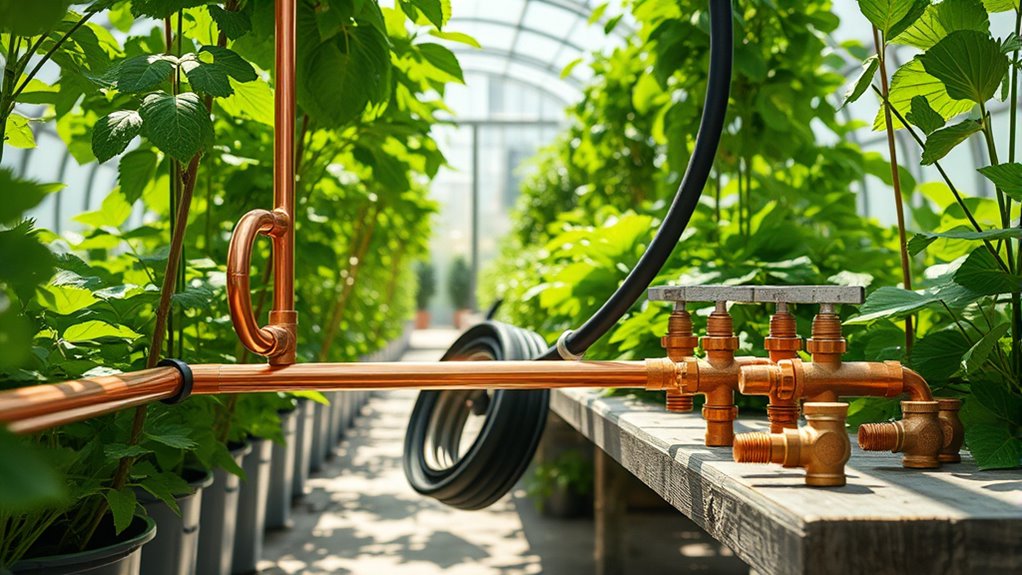
To create an effective irrigation system in your greenhouse, you’ll need to gather a variety of essential materials and components tailored to your watering method.
If you opt for drip irrigation, stock up on mainline tubing, drip tape, emitters, filters, and pressure regulators to guarantee efficient watering.
For hand watering, get watering wands, water breakers, on/off valves, hoses, and watering cans for precise control.
If you prefer semi-automated systems, include controllers, solenoid valves, check valves, PVC piping, and electrical wiring.
For subirrigation, gather troughs, spaghetti tubes, pumps, storage tanks, and filtration systems.
Finally, don’t forget additional tools like fertilizer injectors, hold down stakes, punch tools, cutting tools, and timers to enhance your setup.
Step-by-Step Installation Process

To get your irrigation system up and running, you’ll first need to connect it to a reliable water source.
Once that’s set, focus on placing your emitters strategically to guarantee each plant gets the right amount of water.
This step is essential for maximizing efficiency and promoting healthy growth in your greenhouse.
Water Source Connection
How do you connect your water source to the irrigation system in your greenhouse? Start by selecting your water source, whether it’s groundwater, surface water, municipal water, or rainwater. Next, gather your installation materials: a timer, filter, pressure regulator, and mainline tubing.
Here’s a quick reference table for your setup:
| Component | Purpose | Notes |
|---|---|---|
| Timer | Controls watering schedule | Automates irrigation |
| Filter | Prevents emitter clogging | Essential for water quality |
| Pressure Regulator | Maintains ideal pressure | Ideal range: 15-50 psi |
| Mainline Tubing | Delivers water to plants | Use 1″ or ¾” PVC or polyethylene |
Once everything’s in place, conduct a system test to verify effective operation!
Emitter Placement Guidance
After connecting your water source and setting up the necessary components, it’s time to focus on emitter placement.
First, consider your soil type; place emitters closer together in sandy soils (12 inches apart) and farther apart in clay soils (24 inches). Position emitters directly in the root zone for ideal absorption.
For container plants, place emitters 2 to 3 inches from the edge, slightly off-center. Choose the right flow rate based on plant needs—larger plants might require higher rates.
As your plants grow, adjust emitter positions to match their expanding root systems.
Finally, secure all lines and test the system for leaks, ensuring even water distribution across your greenhouse.
Ensuring Efficiency and Effectiveness
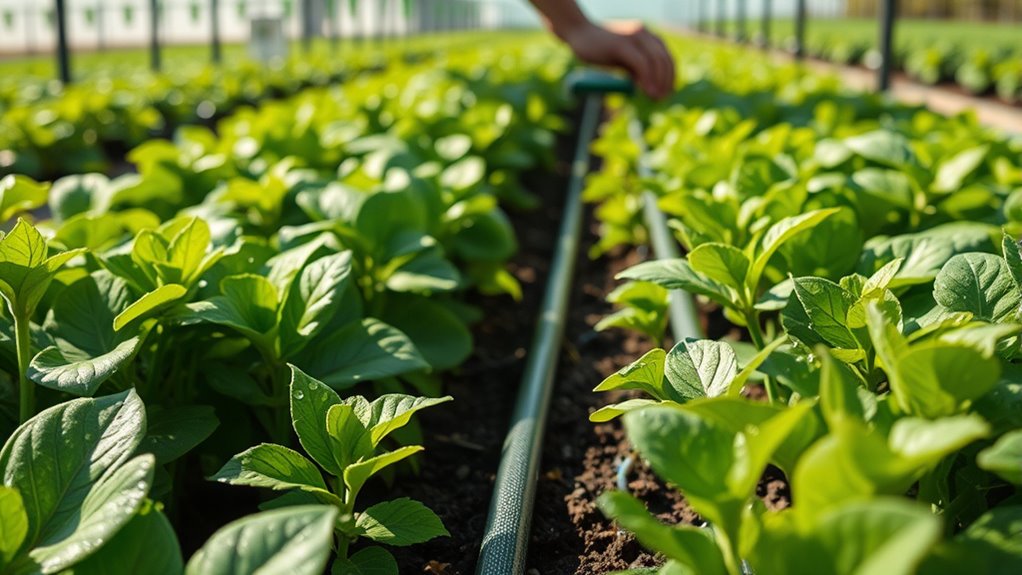
Ensuring efficiency and effectiveness in your greenhouse irrigation system is essential for maximizing plant health and conserving water. Start by measuring irrigation efficiency, which gauges how much water meets plant needs versus what’s wasted. Utilize application methods like drip or subirrigation to reduce disease risk and water waste. Group plants with similar water needs for optimized management, adjusting as they grow.
| Factor | Considerations |
|---|---|
| Application Method | Drip or subirrigation |
| Plant Grouping | Similar water needs |
| Monitoring Tools | Flow meters and soil moisture sensors |
Maintenance and Upkeep Strategies
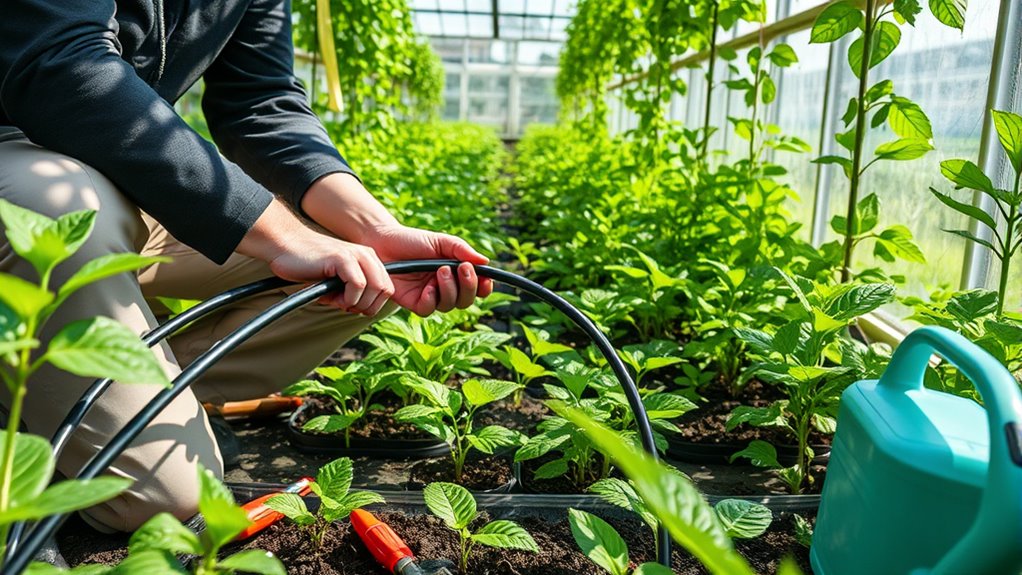
To keep your irrigation system running smoothly, regular filter cleaning and leak detection checks are essential.
You’ll want to inspect filters frequently to guarantee ideal water flow and catch any leaks before they cause bigger problems.
Regular Filter Cleaning
Regular filter cleaning is essential for maintaining the efficiency of your greenhouse irrigation system. By keeping filters clean, you guarantee that water flows freely and your plants receive the nutrients they need.
Here are some key points to remember for regular maintenance:
- Inspect and flush filters monthly to prevent buildup and guarantee peak performance.
- Flush Y filters quarterly or more often if your system clogs easily.
- Consider chemical cleaning for severe buildup using safe agents like chlorine or acid.
Make it a habit to check the pressure differential regularly. A rise in pressure indicates a dirty filter.
With consistent attention to filter maintenance, you’ll maximize your irrigation system’s effectiveness and keep your greenhouse thriving!
Leak Detection Checks
Every greenhouse owner should prioritize leak detection checks as part of their irrigation system maintenance.
Start with visual inspections, looking for water pooling or wet spots. Utilize soil moisture sensors to identify areas with excess water. Pressure testing can reveal leaks by noting any pressure drops. Flow meters help monitor water flow rates, highlighting any sudden changes.
For advanced detection, consider infrared thermography to spot temperature anomalies. Implement system isolation techniques by using shut-off valves and inspecting valves and sprinkler stations.
Regular inspections and seasonal adjustments are essential for upkeep. Don’t overlook technology upgrades, like acoustic leak detection or thermal imaging, to enhance your detection capabilities and guarantee your irrigation system runs efficiently.
Additional Factors to Consider
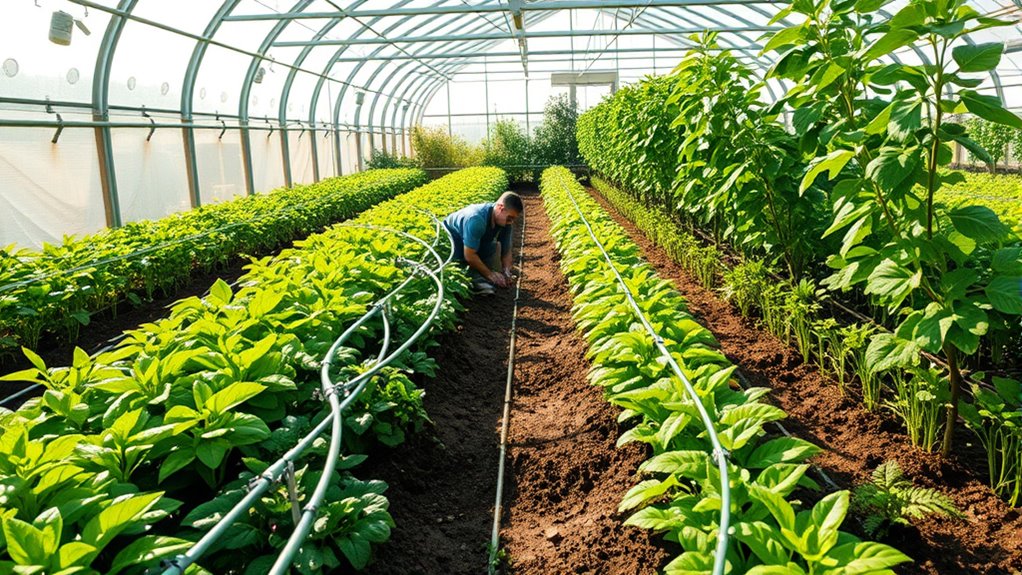
While you may have a solid irrigation system in place, several additional factors can greatly impact your greenhouse’s overall success.
To guarantee ideal plant health and growth, consider these key elements:
- Water Quality: Regularly test for chemicals and pathogens to maintain a healthy environment.
- Crop-Specific Needs: Different plants require varying amounts of water based on their size and growth stage.
- Environmental Conditions: Monitor light intensity, temperature, and humidity levels to adjust your irrigation accordingly.
Frequently Asked Questions
How Can I Determine My Greenhouse’s Water Requirements?
To determine your greenhouse’s water requirements, assess the crop types and their growth stages, as each has specific needs.
Monitor weather conditions, like temperature and humidity, since they influence transpiration rates.
Evaluate your growing structure’s design and size, which affects water usage.
Finally, analyze your irrigation system’s efficiency and the growing medium’s water retention capabilities.
What Are the Benefits of Automated Irrigation Systems?
Automated irrigation systems offer you significant benefits.
They reduce water waste by delivering water directly to the roots, ensuring optimized water use.
You’ll enjoy consistent moisture levels, enhancing plant health and growth.
Plus, these systems save you time and labor, allowing you to focus on other gardening tasks.
With minimal maintenance and lower utility bills, automated systems not only support environmental conservation but also improve your overall gardening efficiency and productivity.
How Often Should I Run My Irrigation System?
You should run your irrigation system based on the season and your plant’s specific needs.
In hot summer months, you might need to water daily or every other day, while in winter, less frequent watering suffices.
Keep an eye on your soil type; sandy soils dry out faster, requiring more frequent irrigation.
Always check moisture levels to avoid overwatering, ensuring your plants get the right amount of water to thrive.
Can I Use Rainwater for My Irrigation System?
Of course you can’t use rainwater for your irrigation system—unless you want your plants to thrive and save money!
Rainwater’s purity and lack of chemicals make it a fantastic choice for irrigation. It’s cost-effective, reduces your reliance on municipal water, and promotes sustainability.
By collecting it, you give your plants the best chance to flourish while enjoying the benefits of a healthier environment.
Why wouldn’t you want to take advantage of this natural resource?
What Crops Benefit Most From Drip Irrigation?
If you’re considering drip irrigation, you’ll find that several crops thrive under this system.
Vegetable crops like tomatoes, peppers, and leafy greens need consistent moisture, making them ideal candidates.
Fruit and nut trees benefit from deep watering, while row crops like corn and soybeans maintain optimal moisture levels.
Even flowers and ornamentals, such as roses and marigolds, flourish with drip irrigation.
Conclusion
In the end, you might think that setting up an irrigation system in your greenhouse is just about watering plants, but it’s so much more. By carefully planning, choosing the right materials, and maintaining your system, you’ll create an oasis of growth. Ironically, while it seems like you’re just giving your plants what they need, you’re actually cultivating a deeper relationship with nature. So, go ahead—let technology do the work while you reap the rewards.
